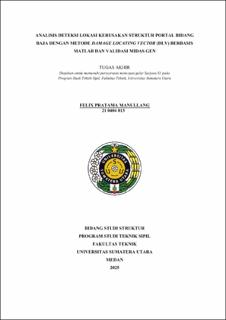Analisis Deteksi Lokasi Kerusakan Struktur Portal Bidang Baja dengan Metode Damage Locating Vector (DLV) Berbasis MATLAB dan Validasi Midas Gen
Damage Localization Analysis of A Steel Plane Frame using the Damage Locating Vector (DLV) Method: Matlab-Based Study with Midas Gen Validation

Date
2025Author
Manullang, Felix Pratama
Advisor(s)
Tarigan, Johannes
Metadata
Show full item recordAbstract
This research is motivated by the need for early damage detection methods to ensure the structural integrity of civil infrastructure. This study aims to apply the Damage Locating Vector (DLV) method to localize damage in a steel plane frame model. Furthermore, it evaluates the influence of sensor quantity and configuration on the detection accuracy for single and multiple damage scenarios.The research employs a numerical analysis of a four-story steel plane frame model implemented in MATLAB. Damage was simulated as a 50% stiffness reduction in selected elements. The DLV method was implemented by analyzing the change in the flexibility matrix between the healthy and damaged states using Singular Value Decomposition (SVD). The resulting virtual load vectors were then applied to the healthy model to identify damaged elements, which are indicated by a Normalized Stress Index (NSI) value approaching zero. To verify the accuracy of the results, this stress response from the DLV load was validated using the output from the Midas Gen. The results indicate that the DLV method is highly effective for detecting single-damage cases. For multiple-damage scenarios, detection accuracy was found to be more dependent on the sensor placement strategy than on the mere quantity of sensors. A strategically distributed sensor configuration accurately localized both damages, whereas a less distributed layout with the same number of sensors yielded suboptimal results. In conclusion, the flexibility-based DLV method is effective for damage localization. However, to ensure accuracy in multiple-damage scenarios, optimizing the sensor configuration is more critical than simply increasing the number of sensors.
Collections
- Undergraduate Theses [1609]
